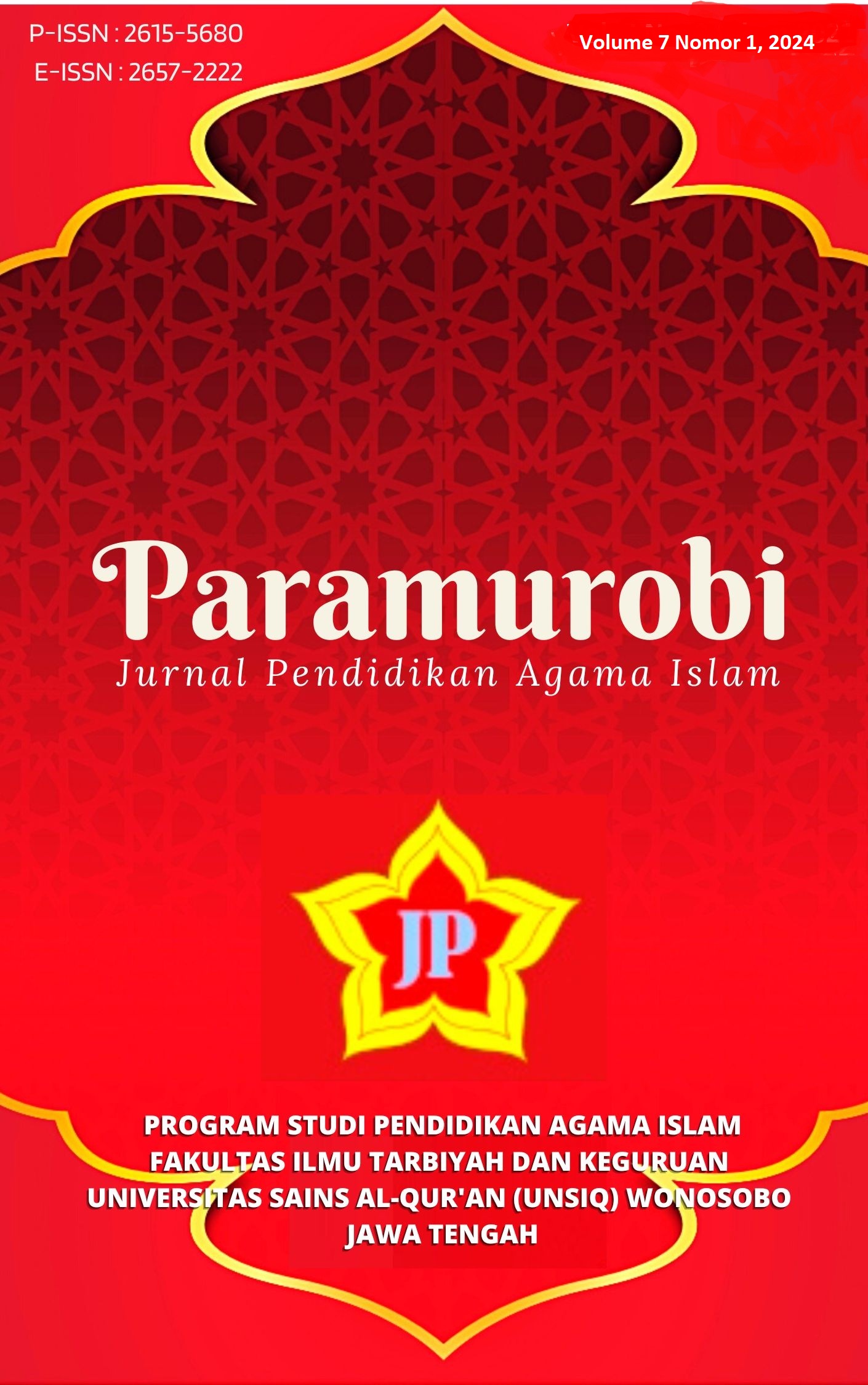MODEL PEMBELAJARAN TAHFIDZUL QUR’AN DENGAN INTERNALISASI NILAI NEUROSAINS
DOI:
https://doi.org/10.32699/paramurobi.v7i1.6834Keywords:
tahfidzul Qur'an learning, the neuroscience-based learningAbstract
The learning model for tafidzul Qur'an is currently in the spotlight of educational scientists in the current era, seeing the achievements and processes of the tafidzul Qur'an model only on rote learning, in this era students' needs must be critical, innovative, and creative to deal with life's problems. So this research provides neuroscience value in the thafidzul Qur'an learning model to optimize all students' brain cells. The use of research is library research in collecting literature in books, journals, and other information media. The stages of in-depth analysis begin by collecting literature, selecting, analyzing, or comparing, and drawing conclusions.
The results of offering neuroscience values in learning tahfidz al-Qur'an provide a new cycle in the learning process so that students achieve long-term memory, through the stages of the neuroscience-based learning process in facilitating students in memorizing the al-Qur'an and hadith
References
Asma, Suyadi Huda, M. (2021). Character Education As Brain Education : Neuroscience Studies In Islamic Education. Jurnal Tarbiyatuna, 12(2), 77–86.
Atmojo, A. M., Perawironegoro, D., & Umam, K. (2022). Change Management Framework : Development Curriculum Of Islamic Education At School. Indonesian Journal Of Education And Social Studies (IJESS), 01(01), 1–11.
Batubara, H. H. (2018). Educational Neuroscience Dalam Pendidikan Dasar. JPD: Jurnal Pendidikan Dasar, 2, 140–148.
Fabiana Meijon Fadul. (2019). Metode Tahfidzul Qur’an (Studi Komparatif Di Pptq Baitul Abidin Darussalam, Pp Hidayatul Qur’an, Dan Pp Ma’had Mambaul Qur’an Wonosobo). Qaf: Jurnal Ilmu Al-Qur’an Dan Tafsir, III, 135–153.
Hidayat, B. (2017). Pembelajaran Alquran Pada Anak Usia Dini Menurut Psikologi Agama Dan Neurosains. The 2nd Annual Conference On Islamic Early Childhood Education Yogyakarta, August 28th 2017 Fitrah, 2, 60–68.
Huriyah, L., Fahmi, M., Baru, R., & Ilaihi, W. (2020). Quo Vadis Higher Order Thinking Skills ( HOTS ) Pada Soal UM-PTKIN Materi Pendidikan Agama Islam. Jurnal Pendidikan Agama Islam (Journal Of Islamic Education Studies), 8(2), 133–152.
Jailani, M., Mauli, B., & Bustam, R. (2021). Meneguhkan Pendekatan Neurolinguistik Dalam Pembelajaran : Studi Kasus Pada Pembelajaran Bahasa Arab Madrasah Aliyah. Al Tariqah Pendidikan Agama Islam, 6(1), 152–163.
Latip, A. E. (2022). Analysis Of Learning Innovation In Madrasah Ibtidaiyah ( A Diffusion Study ). Premiere Educandum: Jurnal Pendidikan Dasar Dan Pembelajaran, 12(June), 125–142. Https://Doi.Org/10.25273/Pe.V12i2.11702
Lestari, R. (2021). High Order Thinking Skills (Hots) Dalam Pendidikan Agama Islam Berbasis Neurosains. Tadrib, 7(1), 61–70.
Maulita, Relly, Ermis Suryana, A. Rahmansyah. (2022). Neurosains Dalam Proses Belajar Dan Memori. Inovatif, 8(2), 1–16.
Muzaki, A., & Mawardi, I. (2022). Implementasi Model Evaluasi Cipp Dalam Pembelajaran Tahfidzul Qur’an. Seminar Nasional Paedagoria, 2, 201–207. Http://Journal.Ummat.Ac.Id/Index.Php/Fkip/Article/View/10139%0Ahttp://Journal.Ummat.Ac.Id/Index.Php/Fkip/Article/Download/10139/Pdf
Noer, S., Evi, ;, & Rusydiyah, F. (2019). Model Evaluasi Pembelajaran Tahfidzul Qur’an Berbasis Coin Pro 2 (Studi Komparasi Pembelajaran Tahfidz Di Turki, Malaysia Dan Indonesia). EDURELIGIA: Jurnal Pendidikan Agama Islam, 3(2), 138–150. Https://Ejournal.Unuja.Ac.Id/Index.Php/Edureligia/Article/View/1128
Prayoga, A. Dkk. (2018). Manajemen Pembelajaran Tahfidzul Quran Berbasis Metode Yaddain Di Mi Plus Darul Hufadz Sumedang. Nidhomul Haq: Jurnal Manajemen Pendidikan Islam, 21, 141–154.
Qolbiyah, A. S., Ismaya, E., & Purnamanita, I. (2022). Edukatif : Jurnal Ilmu Pendidikan Teori Pemrosesan Informasi Dan Neurosains Dalam Pengembangan Metodologi Pembelajaran Pendidikan Agama Islam. Edukatif: Jurnal Ilmu Pendidikan, 4(3), 4813–4827.
Raihan, M. Dkk. (2022). Optimalisasi Penggunaan Metode J-Qaf Dengan. Al Ulya: Jurnal Pendidikan Islam, 7(September), 50–64.
Ramadhani, A. A. (2022). Implementasi Metode Ummi Dalam Pembelajaran Tahfidz Di Panti Asuhan Tahfidzul Quran Yatim Piatu Muhammadiyah Belegondo Ngariboyo Magetan. MA’ALIM: Jurnal Pendidikan Islam, 3(1), 21–32.
Rusdianto. (2015). Interaksi Neurosains Holistik Prespektif Pendidikan Dan Masyarakat Islam. Hunafa Jurnal Studia Islamika, 12, 71–94.
Salman, Alparisi Salman, Dkk. (2021). Implikasi Model Pembelajaran Terhadap Brain Development (Neurosains). Jurnal Smart Paud, 4(1), 23–29.
Sifa, A. U., Firmansyah, D., & Fauziya, D. S. (2022). Neurosains Pada Think Talk Write ( Ttw ) Dalam. Parole ( Jurnal Pendidikan Bahasa Dan Sastra Indonesia, 5(2016), 1–8.
Suntoro, R. (2021). Akal Bertingkat Al-Farabi Dalam Perspektif Neurosains Dan Relevansinya Dengan Pendidikan Sains Di Madrasah Ranu Suntoro Akal Bertingkat Al-Farabi Dalam Perspektif Jurnal Ilmu Tarbiyah “ A T-Tajdid ”, Vol . 10 No . 1 , Januari 2021 Akal Bertingkat Al-Farab. At-Tajdid: Jurnal Ilmu Tarbiyah, 10(1), 303–327.
Suyadi, Sadam, M. J. (2021). Creative Imagination Of Islamic Education Learning Perspectives In Neuroscience Discourse: Implications For Students In Schools. Al-Mudarris Journal Of Education, 4(2), 152–172. Https://Doi.Org/10.32478/Al-Mudarris.V
Suyadi. (2019a). Hybridization Of Islamic Education And Neuroscience : Transdisciplinary Studies Of ’ Aql In The Quran And The Brain In Neuroscience. Dinamika Ilmu, 19(2), 237–249.
Suyadi. (2019b). Millennialization Of Islamic Education Based On Neuroscience In The Third Generation University In Yogyakarta Indonesia. Journal, Qudus International Volume, Islamic Studies, 7(1), 173–202.
Wahyudi, Nanang, Ranu Suntoso, A. (2020). Pengembangan Higher Order Thinking Skill Dalam Pendidikan Islam Berbasis Neurosains. At-Tajdid: Jurnal Ilmu Tarbiyah, 9(2), 107–129.
Wiyarto, A. (2013). Motivasi Menghafal Al Qur’an Pada Mahasantri Pondok Pesantren Tahfizhul Qur’an Di Surakarta. Tesis, 2, 1–7.
Downloads
Published
Issue
Section
License
Copyright Notice
1. Authors retain copyright and grant the journal right of first publication with the work simultaneously licensed under a Creative Commons Attribution License (CC BY-SA 4.0) that allows others to share (copy and redistribute the material in any medium or format), and adapt (remix, transform, and build upon the material) the work for any purpose, even commercially with an acknowledgement of the work's authorship and initial publication in this journal.
2. Authors are able to enter into separate, additional contractual arrangements for the non-exclusive distribution of the journal's published version of the work (e.g., post it to an institutional repository or publish it in a book), with an acknowledgement of its initial publication in this journal.
3. Authors are permitted and encouraged to post their work online (e.g., in institutional repositories or on their website) prior to and during the submission process, as it can lead to productive exchanges, as well as earlier and greater citation of published work (See The Effect of Open Access).





